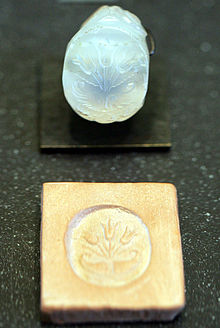Stamp seal
The stamp seal or seal stamp is an embossing tool cut into hard, durable material ( stone , later also metal ), consisting of a handle and embossing plate, for making impressions in a malleable medium such as clay, wax or sealing wax . In these prints is symbols , inscriptions , pictures, signatures or territorial symbols , in the European Middle Ages, especially in the sealing of documents also to crest .
The oldest finds prove that the stamp seal was initially used in the form of an amulet . They are recorded for the first time in the area of Çatalhöyük in Anatolia ( seventh millennium BC ). About 1000 years later, forms of this amulet stamp seal appeared in Mesopotamia and the region of what was later to be Assyria . In contrast to the cylinder seal , the stamp seal is pressed into the seal lump from above.
Compared to the cylinder seal, which always leaves a rectangular roll imprint, the stamp seal can, in addition to the character content, also have a certain shape for differentiation and classification, such as round, oval, square, diamond-shaped or more complex. The stamp seal became the preferred embossing tool in Mesopotamia initially almost entirely through the there between 3200 BC. BC and 3100 BC Introduced cylinder seals. The Assyrians did not implement it until the 9th century BC. A renaissance of the stamp seal.
See also
literature
- Dietz-Otto Edzard among others: Reallexicon of Assyriology and Near Eastern Archeology . Volume 3. de Gruyter, Berlin 1999, ISBN 3-1100-3705-X .
- Dietz-Otto Edzard: History of Mesopotamia. From the Sumerians to Alexander the Great. Beck, Munich 2004, ISBN 3-406-51664-5 , ( Beck's historical library ).
- Gebhard J. Selz : Sumerians and Akkadians. History, society, culture. Beck, Munich 2005, ISBN 3-406-50874-X , ( Beck'sche series 2374 CH Beck Wissen ).
